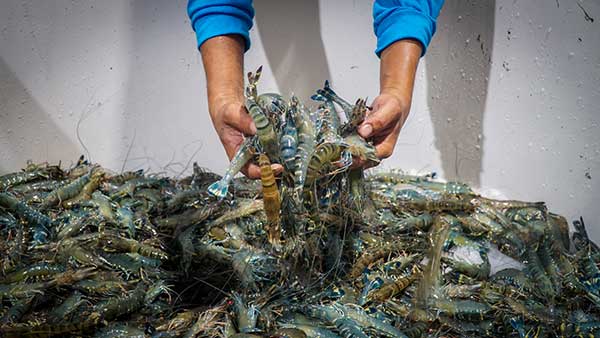
By Joseph Bernard A. Marzan
The Southeast Asian Fisheries Development Center’s (SEAFDEC) Aquaculture Department (AQD) announced a milestone this year, harvesting more than five tons of black tiger shrimp (Penaeus monodon) at one of its stations in Iloilo province.
The series of harvests, conducted on September 10, 16, and 19 at SEAFDEC-AQD’s Dumangas Brackishwater Station, is part of the ‘Oplan Balik Sugpo’ program.
Locally known as sugpo or lukon, the shrimp were cultured for 120 days in a pond from 200,000 fry produced at AQD’s Tigbauan hatchery and stocked at a density of 25 pieces per square meter.
According to the September 10 production report, the shrimp had an average body weight of 28 grams, a survival rate of 89.78 percent, and a feed conversion ratio (FCR) of 1.39.
FCR is a standard measure of livestock production efficiency, calculated by dividing the weight of the feed intake by the weight gained by the animal.
A 2018 report by food systems platform TABLE cited a typical FCR for farmed shrimp between 1.0 and 2.4.
The ‘Oplan Balik Sugpo’ program, launched by AQD chief Dan Baliao in 2017, seeks to revive and strengthen black tiger shrimp production in the Philippines.
It focuses on improving local broodstock, enhancing biosecurity practices, and promoting sustainable farming to boost industry productivity and resilience.

The program was initiated in response to the decline of tiger shrimp culture in the country.
In 1995, the industry produced 88,815 tons of shrimp worth PHP 19 billion, but recovery efforts were needed in subsequent years.
SEAFDEC has previously harvested over 7.2 tons of black tiger shrimp in October and November of 2019.
In July 2023, as part of its 50th-anniversary celebration, SEAFDEC-AQD inaugurated a new Black Tiger Shrimp Broodstock Facility at its Tigbauan station.
The facility includes four 120-ton broodstock tanks aimed at reducing reliance on wild shrimp spawners, which often carry diseases that can affect eggs and larvae.






















